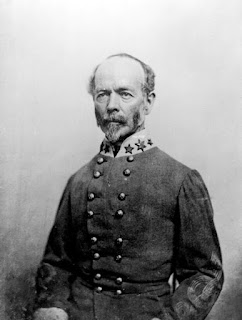Click 👉TODAY IN HISTORY (general history) March 22.
ON THIS DAY IN CONFEDERATE HISTORY, March 22.
1862: Gen. Stonewall Jackson in the Shenandoah Valley Campaign received orders from Gen. Joseph E. Johnston that he was to not let Gen. Nathaniel Banks' Federals leave the valley. Jackson's army marches 22 miles on this day to catch the retreating Yankees. Jackson's cavalry, under Col. Turner Ashby, fights a skirmish with the Federals under Maj. Gen. James Shields, who is wounded in the engagement.
Lt. Gen. T.J. "Stonewall Jackson
(Click on the image to enlarge)
1863: More fighting continues in the vicinity of Murfreesboro, Tenn. between the blue and the gray. In Kentucky, Brig. Gen. John Hunt Morgan and Brig. Gen. John Pegram both continue their raids in Kentucky.
1865: Lt. Gen. Nathan Bedford Forrest has been dispatched to stop the Federal cavalry raid of Brig. Gen. James H. Wilson, which began on this day with 13,480 troopers. But the Confederates only had some 5,000 men poorly equipped and widely scattered to stop them.
CONFEDERATE GENERAL BIRTHDAYS, March 22.
General Braxton Bragg was born on this day in 1817 in Warrenton, North Carolina. He graduated from West Point in 1837 ranking fifth out of 50 graduates in the class. In his U.S. Army career, he served in the Seminole War and the Mexican War where he performed brilliantly commanding an artillery battery. Bragg resigned from the army effective Jan. 3, 1855, and became a sugar cane planter in southeast Louisiana. He was also active politically and a major general in the Louisiana militia. On orders from the governor, he led 500 state militia in a non-violent takeover of the U.S. Arsenal in Baton Rouge on Jan. 11, 1861. With the formation of the Confederacy, he became a brigadier general in the Confederate and was quickly promoted to major general and led a corps in the Battle of Shiloh. He took command of what would be renamed the Army of Tennessee. His abrasive personality and martinet treatment of the men alienated many of his subordinate generals and enlisted men. He led the army in the battles of Perryville, Murfreesboro, Tullahoma, Chickamauga, and Missionary Ridge, after which he resigned his command. At the end of the war, he again led troops in defeats at Second Fort Fisher, Wyse Fork, and Bentonville. He had a wide range of jobs after the war and finally moved to Texas and died there in Galveston on Sept. 27, 1876, and was buried in Magnolia Cemetery in Mobile, Alabama.

Gen. Braxton Bragg
👱
Major General William Henry Chase Whiting was born on this day in Biloxi, Mississippi. He graduated first in his class at West Point in 1845. He had a variety of assignments as an engineer in the army but missed service in the Mexican-American War. Whiting resigned from the U.S. Army on Feb. 20, 1861, joined the Confederate Army engineer serving under General Beauregard at Charleston, S.C. improving defenses there, and was promoted to brigadier general. He also served as the chief engineer on the staffs of other generals and was assigned to command a division in the Peninsula Campaign and was made a wing commander at Seven Pines on May 31, June 1, 1862. Whiting led his division at Gaines' Mill, Malvern Hill, and was given command of the District of Wilmington, North Carolina. Whiting was wounded in the thigh and captured at the Second Battle of Fort Fisher, N.C. He died a prisoner of war on March 10, 1865, of dysentery at Fort Columbus on Governors Island, New York.

Maj. Gen. William H.C. Whiting
👱
Brigadier General William Wirt Adams was born on this day in 1819 in Frankfort, Kentucky. Prior to the war, he gained a little military experience when he joined the army in 1839 in the Republic of Texas as a private. He was promoted captain and adjutant of a regiment and took part in a campaign against Indians in northeast Texas. Adams moved back to Mississippi and became a banker and was elected to two terms in the Mississippi legislature. In the War For Southern Independence, he became a brigadier general and led a cavalry brigade. His battles included Shiloh, Corinth, Iuka, Hatchie's Bridge, Raymond, Champion Hill, Vicksburg, Port Hudson, and Meridian. He was paroled at Gainesville, Alabama, on May 12, 1865. Following the war, he had a variety of jobs in Mississippi, including as a revenue agent, and postmaster. He was killed May 1, 1888, in Jackson, Miss. in a gun battle with a newspaper editor who had criticized him, and he also killed the editor. Adams was buried in Greenwood Cemetery in Jackson.

Brig. Gen. William W. Adams
👱
Brigadier General Francis Asbury Shoup was born on this day in 1834 in Laurel, Indiana. He graduated from West Point in 1855, fifteenth in his class of 34 cadets. He served in the Seminole War and resigned from the army on Jan. 10, 1860, and settled in Indianapolis, Ind. where he was a lawyer and commanded the Indianapolis Zouave militia. He moved to St, Augustine, Florida in 1860 to continue his legal career. With the coming of the war, his Southern sympathies led him into the Confederate Army and he served as chief of artillery under Maj. Gen. William J. Hardee at the Battle of Shiloh. Shoup was promoted to brigadier general on Sept. 12, 1862, and he commanded a division at the Battle of Prairie Grove. Shoup commanded a Louisiana brigade at the Siege of Vicksburg, being captured along with the garrison at the end. After being exchanged, he served in the Battle of Atlanta and became the chief of staff for General John Bell Hood in the Army of Tennessee. Following the war, Shoup was a professor at the University of Mississippi and the University of the South. Shoup also became an Episcopal rector. He died Sept. 4, 1896, in Columbia, Tenn., and was buried at the University of the South.

Brig. Gen. Francis A. Shoup
👋










































































